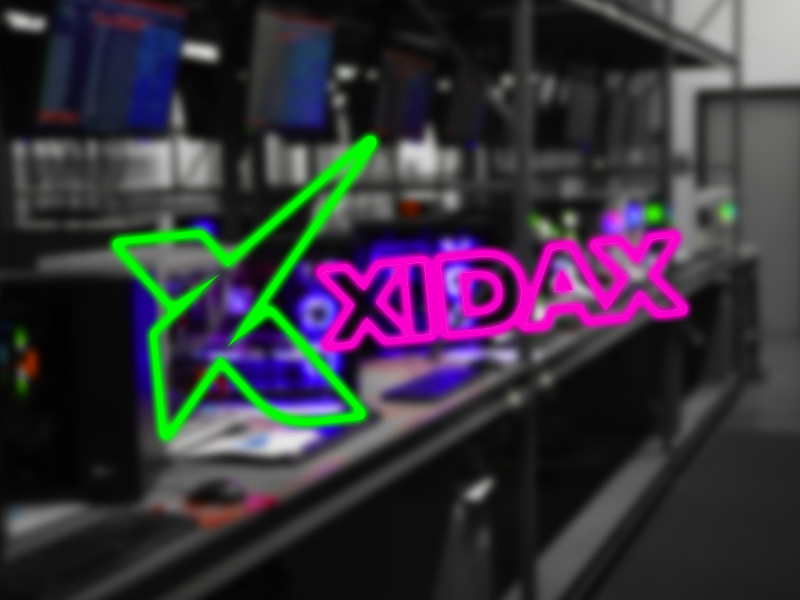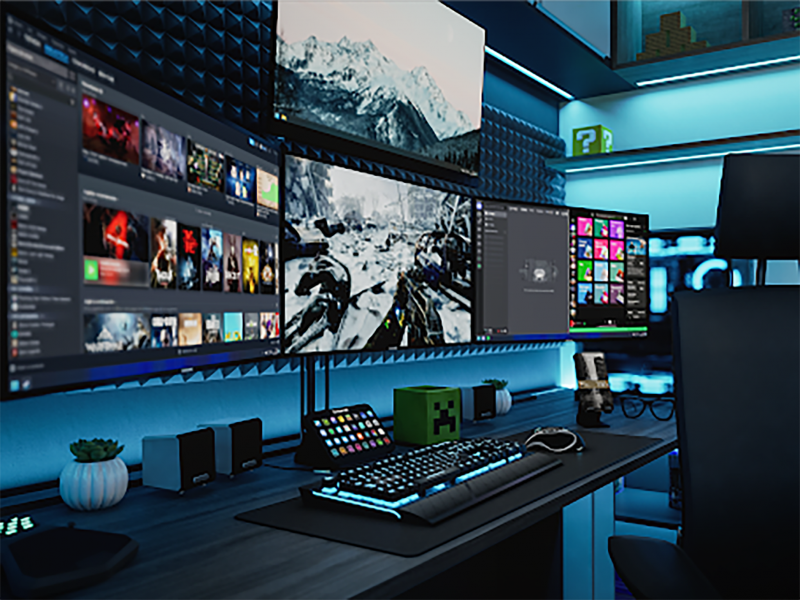
What AMD's Computex 2025 Keynote Means for Your Next Gaming Rig, AI PC, or Workstation
Think big by going small.
That was AMD’s mantra at Computex 2025, and they delivered in a big way. Whether you’re a gamer chasing silky-smooth frame rates, a creator building with pro-grade software, or a tech-forward professional exploring AI workflows, AMD just gave us all a glimpse into the future of computing — and it’s fast, efficient, and smarter than ever.
As a system integrator specializing in high-performance custom builds, Xidax is already preparing our lineup to take full advantage of what’s coming. In this article, we’ll break down the biggest announcements from AMD across three major fronts: Gaming PCs, AI PCs, and Workstations — and what they mean for your next upgrade or custom build.
Check out the full keynote here:
Gaming PCs: RDNA 4, FSR 4, and the RX 9060 XT
Gaming has always been AMD's proving ground, and this year, they doubled down with a slew of GPU and rendering tech designed to push immersive visuals even further.
RDNA 4 Architecture: Accessible High-End Gaming
AMD unveiled RDNA 4 — their latest graphics architecture — built for enthusiasts but accessible to everyone. With better efficiency, higher AI compute throughput, and support for next-gen rendering features, RDNA 4 is a significant leap forward.
One of the first GPUs to use this architecture is the Radeon RX 9060 XT. Set to launch under $350, this 1440p gaming powerhouse features 16GB of VRAM, 821 TOPS of AI compute, and real-world benchmarks that appear to beat out the 5060 Ti by up to 15% in performance-per-dollar metrics.
It’s not just about raw performance anymore — it’s about smart performance.
FSR 4 and FSR Redstone: AI-Powered Visuals
AMD also announced FSR 4 (FidelityFX Super Resolution) and teased its upcoming evolution: FSR Redstone. These aren’t just upscalers. They’re machine-learning-powered pipelines designed to:
· Reconstruct missing frame detail
· Predict light behavior in real-time
· Apply AI-enhanced frame generation
· Maintain cinematic quality with less brute-force rendering
All of that means better graphics for you, in a more efficient system.
For example, AMD showed off Ghost of Tsushima running with FSR 4 side-by-side against FSR 3. The difference? Razor-sharp clarity even in fog, smoke, and fire effects. FSR 4 keeps the artistry intact where older versions blurred the details.
And FSR Redstone takes this further with:
· Neural Radiance Caching: Predicts lighting from previous frames and nearby pixels
· Ray Regeneration: Filters noisy ray-traced data in real time
· ML Super Resolution + Frame Gen: Boosts performance while preserving high fidelity
· Anti-Lag Integration: Ensures ultra-responsive input
What It Means for Gamers: Expect better visuals at higher framerates, even on mid-range hardware (if true, that's a huge win for those on a budget). And with features like Redstone requiring AI compute, having a GPU like the RX 9060 XT will unlock the full experience.
We’re already looking at RDNA 4 builds optimized for these technologies, so if you're looking to future-proof your next system, stay tuned for more details from us.
AI PCs: Local Intelligence at Your Fingertips
The biggest computing revolution right now? It isn’t just in the cloud — it’s on your desk.
AMD's new Ryzen AI 300 series, featuring the Ryzen AI Max, delivers on-device AI performance that outpaces competitors by a huge margin. In fact, Ryzen AI Max claims:
· 3x the performance of its nearest AI PC rival
· 15% better performance than Apple’s M4 Pro
But it’s not just about benchmarks. It’s about real-world workflows.
Why Smaller AI Models Are the Future
Large models like GPT-4 are powerful but expensive and slow. Task-specific models, on the other hand, are:
· Faster to run
· More accurate for specific tasks
· Easier to deploy locally
Whether you're translating voice-to-voice in real time or using a custom coding assistant at 35,000 feet without Wi-Fi, on-device AI cuts latency, increases privacy, and boosts productivity.
AMD showed this in action:
· A radiologist AI assistant analyzed X-rays and returned matching reference images and peer-reviewed reports in seconds — all while running on a local AI PC.
· Lenovo and ASUS debuted devices featuring AMD's new AI chips with preloaded productivity agents for business, education, and creative use.
What It Means for You: AI PCs are no longer a niche concept — they’re shipping now. If you rely on real-time tools like content summarizers, media editing assistants, translation software, or localized AI models, your next PC should be built with this in mind.
We're already prepping to build desktop and mobile AI systems built on Ryzen AI Max and 300 series chips, giving professionals, students, and creators access to cutting-edge tools with zero reliance on the cloud. Stay tuned!
Workstations: Meet Shimada Peak and the R9700
Some workloads go beyond gaming and general productivity. For professionals in fields like VFX, simulation, machine learning, and rendering, AMD dropped the mic at Computex with their new high-performance workstation components.
Ryzen Threadripper PRO 9000 Series (Shimada Peak)
If you're a creator or developer who thought Threadripper was already powerful enough, think again. The new Threadripper PRO 9000 series, codenamed Shimada Peak, features:
· Up to 96 cores / 192 threads
· Built on Zen 5 and 4nm process
· Up to 2.2x faster than the previous generation
· World record Cinebench scores
It demolishes simulations, multi-layer renders, and high-res video production pipelines.
Radeon AI PRO R9700 GPU
To pair with Threadripper, AMD also launched the Radeon AI PRO R9700, their most powerful workstation GPU to date:
· 1,500+ TOPS of AI compute (4-bit)
· 32GB of VRAM for large-model training and inference
· 5x faster than RTX 5080 in large model testing
AMD showed this in a four-GPU configuration paired with Shimada Peak to run models like LLaMA 4 and DeepSeek R1 locally, with zero compromise.
What It Means for Pros: Whether you’re rendering 8K video, fine-tuning foundation models, or building AR/VR experiences, this hardware doesn’t just support the future — it builds it. We’re already testing workstation builds that leverage Shimada Peak and the R9700 for our clients in media, science, and design.
ROCm on Windows and Linux: Open AI for All
In addition to hardware, AMD is committing big time to open software with ROCm (Radeon Open Compute). Previously reserved for Linux and hyperscalers, ROCm is now coming to Windows, making AI development more accessible than ever.
What This Unlocks:
· Developers can use PyTorch and ONNX with AMD GPUs
· Researchers can train and run models locally with faster performance
· Creators can use tools like ComfyUI, Hugging Face, and Ollama more seamlessly
Expect day-one support on future GPUs and APUs, with easier deployment and lower system overhead.
What It Means for You: ROCm helps bridge the gap between raw hardware and real-world performance. Whether you're running AI tools for productivity or full model training, ROCm simplifies the process — and makes it viable for creators, researchers, and prosumers alike.
Coming soon, Xidax will be offering systems with ROCm support out of the box, optimized for the latest frameworks and workflows.
The Bottom Line: What Comes Next
AMD's 2025 Computex keynote wasn't just a product showcase. It was a roadmap for the next era of personal computing:
· Gamers get RDNA 4 and FSR Redstone: cinematic visuals without cinematic costs
· Professionals get AI PCs with Ryzen AI Max: powerful, private, and local
· Creators and engineers get Shimada Peak and R9700: redefining workstation capability
· Developers get ROCm on Windows: open source acceleration made easy
We're building systems that integrate these technologies today, not months from now. If you're ready to be among the first to experience this new generation of computing power, we're here to make it happen.
Need help choosing the right setup? Let’s talk. Whether you’re a gamer, developer, artist, or AI innovator — the future is already here, and it’s ready to be customized for you.

